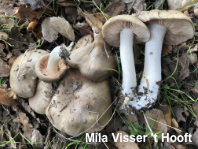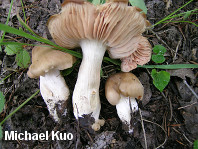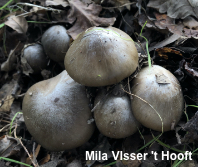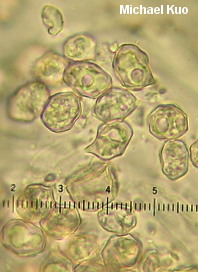| Major Groups > Gilled Mushrooms > Pink-Spored > Entolomatoid Mushrooms > Entoloma lividoalbum |

|
Entoloma lividoalbum [Basidiomycota > Agaricales > Entolomataceae > Entoloma . . . ] by Michael Kuo This large entolomatoid mushroom is fond of hardwoods in western North America (especially quaking aspen and coast live oak), and can be recognized by its fairly large stature (often reminiscent of a Tricholoma), the yellow-brown cap that does not develop a prominently lined margin, the finely lined white stem, and the mealy odor—although the mealy odor is absent in one West-Coast form. Crucial microscopic features include 5- to 6-sided, heterodiametric spores; intracellular pigment in the pileipellis; and the presence of clamp connections. Similar species under hardwoods in the western states include Entoloma ferruginans and Entoloma cinereolamellatum, both of which have gray gills (before turning pink from maturing spores)—and Entoloma subsaundersii, which usually grows in tightly packed clusters and features a cap that is pale when young, from a coating of whitish fibrils, becoming darker brown with age as the fibrils separate (the opposite of the dark-to-light progression of Entoloma lividoalbum). Species in the Entoloma rhodopolium group have lined cap margins and are less sturdy. Entoloma lividoalbum was originally described (Kühner & Romagnesi 1954) from Europe; our North American versions may represent as-yet unnamed species. Thanks to Mila Visser 't Hooft for documenting, collecting, and preserving Entoloma lividoalbum for study; her collection is deposited in The Herbarium of Michael Kuo. Description: Ecology: Saprobic; growing alone, scattered, or gregariously under hardwoods (including quaking aspen and coast live oak); summer and fall, or over winter in coastal California; fairly widely distributed west of the Great Plains; occasionally (perhaps erroneously?) reported from northeastern North America; also known from temperate Europe. The illustrated and described collections are from California and Colorado. Cap: 5–7 cm; conico-convex to bell-shaped or convex at first, becoming broadly convex, broadly bell-shaped, or nearly flat; greasy when fresh; bald; dark grayish brown when young, quickly fading to yellow-brown or grayish tan; the margin not lined or only faintly lined at maturity. Gills: Narrowly attached to the stem; close or nearly distant; at first white, becoming pink with maturity. Stem: 5–8 cm long; 1–2 cm thick; more or less equal; dry; bald but finely lined longitudinally; white. Flesh: Thin; fragile; white. Odor and Taste: Mealy or, in forma inodoratum, not distinctive. Chemical Reactions: KOH on cap surface negative. Spore Print: Pink. Microscopic Features: Spores 7–10 x 6–8 µm; mostly 5- and 6-sided; heterodiametric; smooth; hyaline in KOH. Basidia mostly 4-sterigmate. Hymenial cystidia not found. Pileipellis a cutis with intracellular brownish pigment; elements 5–7.5 µm wide, smooth, hyaline in KOH; terminal cells cylindric with rounded or subacute apices. Clamp connections present. REFERENCES: (Kühner & Romagnesi, 1954) Kubicka, 1975. (Noordeloos, 1988; Largent, 1994; Breitenbach & Kränzlin, 1995; Evenson, 1997; Miller & Miller, 2006; Noordeloos, 2008; Desjardin, Wood & Stevens, 2015; Evenson, 2015; Cripps, Evenson & Kuo, 2016.) Herb. Kuo 08150712, 01122004. This site contains no information about the edibility or toxicity of mushrooms. |
© MushroomExpert.Com |
|
Cite this page as: Kuo, M. (2020, March). Entoloma lividoalbum. Retrieved from the MushroomExpert.Com Web site: http://www.mushroomexpert.com/entoloma_lividoalbum.html |



